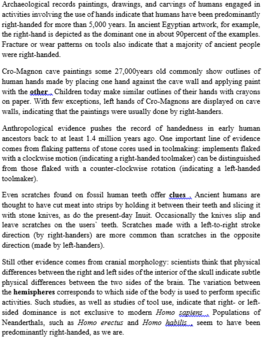Read the following passage and mark the letter A, B, C, or D on your answer sheet to indicate the correct answer to each of the questions from 36 to 43.
The hard, rigid plates that form the outermost portion of the Earth are about 100 kilometers thick. These plates include both the Earth's crust and the upper mantle. The rocks of the crust are composed mostly of minerals with light elements, like aluminum and sodium, while the mantle contains some heavier elements, like iron and magnesium. Together, the crust and upper mantle that form the surface plates are called the lithosphere. This rigid layer floats on the denser material of the lower mantle the way a wooden raft floats on a pond. The plates are supported by a weak, plastic layer of the lower mantle called the asthenosphere. Also like a raft on a pond, the lithospheric plates are carried along by slow currents in this more fluid layer beneath them.
With an understanding of plate tectonics, geologists have put together a new history for the Earth's surface. About 200 million years ago, the plates at the Earth's surface formed a “supercontinent” called Pangaea. When this supercontinent started to tear apart because of plate movement, Pangaea first broke into two large continental masses with a newly formed sea that grew between the land areas as the depression filled with water. The southern one — which included the modern continents of South America, Africa, Australia, and Antarctica — is called Gondwanaland. The northern one — with North America, Europe, and Asia — is called Laurasia. North America tore away from Europe about 180 million years ago, forming the northern Atlantic Ocean. Some of the lithospheric plates carry ocean floor and others carry land masses or a combination of the two types. The movement of the lithospheric plates is responsible for earthquakes, volcanoes, and the Earth's largest mountain ranges. Current understanding of the interaction between different plates explains why these occur where they do. For example, the edge of the Pacific Ocean has been called the “Ring of Fire” because so many volcanic eruptions and earthquakes happen there. Before the 1960's, geologists could not explain why active volcanoes and strong earthquakes were concentrated in that region. The theory of plate tectonics gave them an answer.
Which of the following can be inferred about the theory of plate tectonics?
A. It is no longer of great interest to geologists
B. It was first proposed in the 1960's
C. It fails to explain why earthquakes occur
D. It refutes the theory of the existence of a supercontinent







Đáp án B
Thông tin: Before the 1960's, geologists could not explain why active volcanoes and strong earthquakes were concentrated in that region. The theory of plate tectonics gave them an answer.
Dịch nghĩa: Trước những năm 1960, các nhà địa chất không thể giải thích tại sao núi lửa đang hoạt động và động đất mạnh đã được tập trung ở khu vực đó. Lý thuyết kiến tạo mảng đã cho họ một câu trả lời.
Như vậy, có thể suy ra rằng chỉ từ những năm 1960 trở đi mới có lý thuyết kiến tạo mảng. Phương án B. It was first proposed in the 1960's = Nó lần đầu được đưa ra trong những năm 1960, là phương án chính xác nhất.
A. It is no longer of great interest to geologists = Nó không còn tạo hứng thú lớn cho các nhà địa chất.
Không có thông tin như vậy trong bài.
C. It fails to explain why earthquakes occur = Nó thất bại trong việc giải thích tại sao động đất xảy ra.
The movement of the lithospheric plates is responsible for earthquakes, volcanoes, and the Earth's largest mountain ranges. = Sự di chuyển của các mảng thạch quyển chịu trách nhiệm cho những trận động đất, núi lửa, và các dãy núi lớn nhất của Trái Đất.
Như vậy lý thuyết đó đã thành công khi giải thích hoạt động của núi lửa chứ không phải thất bại.
D. It refutes the theory of the existence of a supercontinent = Nó bác bỏ các lý thuyết về sự tồn tại của một siêu lục địa.
Không có thông tin như vậy trong bài.